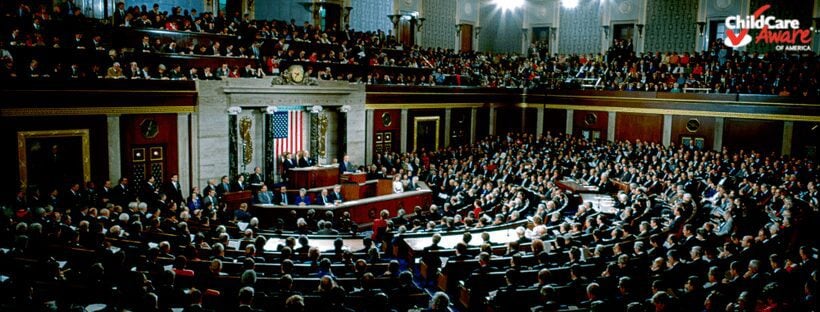-4.png?width=701&height=394&name=Untitled%20design%20(8)-4.png)
Building off a busy legislative year for child care in 2023, we are already seeing early indicators of which states are prioritizing child care investments this year. This is a key moment for states to prioritize child care, as it is unclear if there is a path forward in Congress to secure significant funding in 2024 before federal relief funding is fully exhausted and attention shifts to the November elections. This blog explores the states’ legislative landscape, governors’ stated priorities and what’s next for states in 2024.
State Legislative Landscape, 2024
With control in Congress divided between political parties, contributing to inaction, states made significant headway in 2023 in advancing policies and investments that support child care access, affordability and quality. States continued to spend down federal relief funding, much of which had to be spent by September 30, 2023. At the same time, states—blue, red, and purple— made monumental investments of their own with state general funds, some even doing so for the first time. By September 30, 2024, all states are required to liquidate remaining ARPA-Child Care and Development Fund (CCDF) supplemental dollars. With these remaining federal dollars dwindling and the unlikeliness of a divided Congress agreeing on a major funding package for child care, it will be imperative for states to address child care investments in their 2024 legislative sessions.
Overall, states are in healthy fiscal positions to make long-term funding decisions. The National Association of State Budget Officials (NASBO) annual fiscal survey found that enacted budgets for FY2024 authorized an increase in general fund spending of $1.26 trillion, a 6.5% increase over FY2023. NASBO found that 46 states reported general fund revenue collections exceeded original estimates used in enacted budgets for FY2023 and that preliminary actual collections for FY2023 were up 7.7% compared to original estimates. Twenty-one states reported net mid-year spending increases and while nine states reported net mid-year cuts, only one state attributed the cuts to a revenue shortfall. The report also finds that 41 states had increases in the size of their rainy-day fund balances in 2023.
Despite healthy budgets, there are factors in play that could result in fewer major child care policies enacted in 2024:
- Not every state is in session this year. Montana, Nevada, North Dakota and Texas do not hold regular sessions in even-numbered years, though there is always a possibility for a special session to be called on a particular issue.
- Not every state is scheduled to pass a state budget this year. This could mean fewer big-ticket bills will be introduced because not every state is set to appropriate funds. In 2023, 17 states enacted two-year (biennial) budgets covering both fiscal year (FY) 2024 and FY2025. This leaves 33 states and the District of Columbia that will release a FY2025 budget proposal this year. In three of these states, Kentucky, Virginia and Wyoming, governors will propose a new biennial budget for both FY2025 and FY2026. Governors in the 17 states that passed a biennial budget in 2023 may still release a supplemental or revised budget recommendation for FY2025.
- Some states have a condensed legislative calendar: In a non-budget year, some states hold shorter sessions. With fewer days to consider bills, governors and state legislators tend to narrow the number of bills they consider as they sprint across the finish line. In 2024, 15 states are scheduled to have significantly shorter sessions than in 2023. Only four states are scheduled to have significantly longer sessions.
Executive Branch Priorities, 2024
Governors have started to share their legislative priorities around child care in their opening addresses to the legislature and in their official budget proposals. At least 23 governors mentioned child care in their 2024 State of the State addresses, with Massachusetts Governor Maura Healey (D) and Wisconsin Governor Tony Evers (D) both indicating child care as a main policy priority this session. Missouri’s Governor Mike Parsons (R) invited a parent who qualifies for child care subsidy assistance and an early learning program director as guests to his State of the State address. While not an exhaustive list, governors have proposed the following funding and policy initiatives for child care:
- Arizona’s Governor Katie Hobbs (D) proposed $100 million in additional, one-time state general funding for child care, in addition to the $91 million provided annually in ongoing federal funding. The additional state funding would be used to provide additional support to the state’s subsidy program, allow Arizona to maintain reimbursement rates at the 50th percentile, cover copayments and continue the child care waitlist suspension.
- Alaska’s Governor Mike Dunleavy (R) announced he will soon introduce the Alaska Affordability Act, which will focus on four of the largest expenses that impact a family’s budget, including child care. We’ll be keeping an eye on the introduction of this bill to determine what supports and investments are made for child care.
- California’s Governor Newsom (D) proposed maintaining $723.8 million in funding to implement the recently ratified collective bargaining agreement with child care providers, as well as the agreement to work toward an alternative methodology for estimating the costs of care. The governor notes that by July 2024, California will submit a plan for approval of an alternative methodology. His budget proposal includes $2.1 billion to fund roughly 146,000 new subsidized child care slots expected to be filled by 2024-25. It also includes $53.7 million in general funds to support reimbursement rate increases previously supported by available one-time federal stimulus funding for California’s State Preschool Program. Notably, the governor’s proposal projects a $37.9 billion deficit.
- Colorado’s Jared Polis (D) proposed an additional $21 million for Colorado’s subsidy program to maintain increased provider rates and paid absences. It also includes $6.6 million in ARPA-CCDF funding to cap family copayments at 10% of family income and to fund infants and toddlers based on enrollment to “provide program stability while the federal government considers permanent rule changes.” The governor also proposes $10 million to expand the state’s Child Care Expense Tax Credit and $300,000 to support bilingual licensing of Spanish-speaking child care providers.
- Florida’s Governor Ron DeSantis (R) proposed to maintain current levels of funding for both the state’s subsidy program and T.E.A.C.H. program, and similar funding levels for its Voluntary Pre-Kindergarten program to last year.
- Georgia’s Governor Brian Kemp (R) proposed $4.6 million to increase reimbursement rates to the 50th percentile of market rates; $23.6 million to increase the salary schedule for certified and assistant prekindergarten teachers by $2,500; and $11 million to reduce prekindergarten room sizes from 22 to 20 students over a four-year phase-in.
- Kansas’ Governor Laura Kelly (D) proposed an additional $56.4 million in state general funds for child care and early learning. This includes $30 million in state funding toward Child Care Capacity Accelerator grants to create an estimated 5,655 new child care spots, which will be matched with private funds; $15 million in one-time funding for sustainability grants for child care providers to help offset increased operational costs; and $5 million to apply toward a public-private partnership to establish pilot programs addressing child care availability in Northwest Kansas.
- Kentucky’s Governor Andy Beshear (D) proposed more than $140 million over two years toward child care subsidy, including $40 million yearly to retain current reimbursement rates, which are currently being increased with temporary relief funding. The governor is also proposing an additional $15 million in FY2025 and $20 million in FY2026 from state general funds to make providers who care for children ages 0 through 3 years eligible for subsidy, regardless of income. Kentucky currently has a similar program in place that is supported by expiring relief dollars. The Governor’s proposal also includes $172 million each year to fund universal preschool for all 4-year-old children.
- Maryland’s Governor Wes Moore (D) proposed an additional $218 million in FY2024 and $270 million in FY2025 in state funding for Maryland’s subsidy program.
- Massachusetts’ Governor Maura Healey's (D) proposed major new child care investments and initiatives, including a $56 million increase (4%) for child care over last year’s funding. Other budget highlights include $475 million to continue the state’s stabilization grants (C3 Grants); $75 million to expand subsidy eligibility from 50% state median income (SMI) to 85% SMI and reduce the subsidy waitlist; $65 million for rate increases that are based on the true cost of care; and an additional $21 million for the Commonwealth Preschool Partnership Program (for a total investment of $38.6 million) to put the state on a path to universal prekindergarten in 26 cities by 2026. The governor’s budget would also continue payments based on enrollment.
- Michigan’s Governor Gretchen Whitmer (D) proposed a number of investments for child care in her FY2025 budget recommendations, including $60 million in state funding for a Child Care Benefits for Child Care Workers Pilot, which will provide financial assistance to child care workers to help offset the cost of child care for their own children. Using state general funds, the governor also recommends $37.9 million to increase rates by 10%; $8.5 million to increase rates paid to child care providers for youth who are in foster care; $500,000 to provide technical assistance and supplies intended to ensure water is safe to drink in the state’s child care centers; and $366,500 to provide support for the before- and after-school programs funded in the state school aid budget. Using federal funding, the governor recommends $4.8 million to increase the number of staff who inspect child care facilities and $4 million for Family Child Care Networks to continue support that began with temporary federal stimulus dollars. The governor’s budget also recommends $159.5 million to expand access to the Great Start Readiness Program, Michigan's state-funded preschool program.
- Missouri’s Governor Mike Parsons’ (R) proposed budget includes $51.7 million to increase subsidy rates, which are currently at the 58th percentile for infants, toddlers, preschoolers and school-aged children. His budget would raise rates to the 100th percentile for infants and toddlers and the 65th percentile for preschoolers and school-aged children as based on the most recent market rate study. In his State of the State address, the governor also noted his support for advancing a trio of child care tax credits for taxpayers who donate to support child care centers, for employers who make investments in child care needs for their employees and for child care providers. This bill (HB 1488) is currently advancing in the House.
- New Mexico’s Governor Michelle Lujan Grisham proposed $75 million to the Early Childhood Education and Care Department for child care assistance, utilizing $40 million from the state’s Early Childhood Trust Fund. This includes continuing eligibility for assistance up to 400% federal poverty level (FPL), increasing educator pay and restructuring copayments. Additionally, the governor’s budget proposes $35 million to add 2,000 slots for infant and toddler child care statewide and $33 million to expand early prekindergarten. The governor’s budget also recommends $10 million to support a wage/career ladder for early childhood professionals and $3 million of nonrecurring general fund for low-interest loans, in partnership with New Mexico Finance Authority, to increase infant and toddler care in the state’s child care deserts.
- New York’s Governor Kathy Hochul (D) proposed nearly $1.8 billion to support the recent expansion of family eligibility at 85% SMI and the 1% cap on family copayments. The governor’s budget also proposes $5 million to pilot Family Child Care Networks and $1.7 million to double the amount of early childhood mental health consultations. The governor also recommends the creation of an increased differential payment rate for high-quality providers that are accredited and participate in the state’s QRIS, among other criteria.
- Pennsylvania’s Governor Josh Shapiro (D) proposed a modest increase of $96,000 for child care providers participating in the state’s subsidy system, which will leverage $62 million in federal funding to raise rates to the 75th percentile.
- South Carolina’s Governor Henry McMaster (R) proposed $5 million in non-recurring funds to support the state’s subsidy program and $21.1 million for increased enrollment in South Carolina’s full-day, mixed-delivery 4K program.
- Virginia’s Governor Glenn Youngkin (R) announced his Building Blocks for Virginia Families initiative within his budget proposal, which provides over $448 million in total investments for child care and early education, including an increase of over $300 million in state general funds over FYs 2025-2026. The budget proposal would also allocate the remaining $39 million in federal ARPA State and Local Fiscal Recovery Funds (SLFRF) for child care and requires any remaining SLFRF funds as of June 30, 2024, be transferred to the state’s subsidy program. Most of the increase in state general funds would be used to maintain the number of subsidy slots established using federal relief funds once it expires. Among other child care investments, the governor’s budget also proposes to continue $10 million in direct-to-child care educator payments.
- Wisconsin: While Wisconsin is in the middle of its biennial budget, Governor Tony Evers (D) shared in his State of the State address that finding a long-term funding solution for child care is a legislative priority in 2024. The governor introduced a plan to stabilize child care through the continuation of its Child Care Counts stabilization grant program in fall 2023, but it was rejected by the legislature. As a stopgap measure, Governor Evers directed $170 million in temporary Federal Emergency Management Agency pandemic response funding to continue the state’s stabilization grant program. In his address, Governor Evers called on the state legislature to pass meaningful investments for child care in 2024. Legislative leaders, however, had indicated they plan to adjourn as soon as the end of February or early March because it’s an election year.
What’s Next for State Sessions?
Just three states, Arkansas, Louisiana, and North Carolina, haven’t started their regularly scheduled sessions yet but will gavel in this spring. In at least 33 states, the state legislature will respond to the governor’s budget proposal before coming to a final agreement. Most legislative sessions will wrap up between late March and mid-May, and in 46 states, the new fiscal year begins July 1. Because states had to obligate their remaining ARPA-CCDF dollars by September 30, 2023, we can anticipate that many states will liquidate any remaining funds by the end of their current fiscal year (June 30 for nearly all states).
Outside of the state legislative process, by July 1, 2024, all states must outline their upcoming plans for using CCDF funds. States do this by formally submitting a three-year state plan to the Administration for Children and Families (ACF). As of February 2024, ACF is currently finalizing the FY2025-2027 CCDF Plan Preprint. State agencies are also required to hold at least one public hearing on their CCDF plans. The development of CCDF state plans provides an opportunity for collaboration and idea-sharing among all child care advocates—including parents, providers and CCR&R staff. Stay tuned for resources from CCAoA soon on the CCDF state planning process and how you can weigh in!
Interested in following child care policies trends across all states? Check out CCAoA’s State Policy Dashboard!
BECOME AN ADVOCATE





